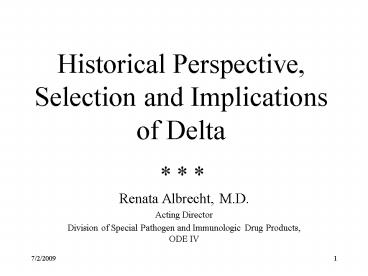Historical Perspective, Selection and Implications of Delta - PowerPoint PPT Presentation
1 / 22
Title:
Historical Perspective, Selection and Implications of Delta
Description:
Delta met, indication not approved due to concerns about safety ... In summary, delta has been one of multiple important factors considered in ... – PowerPoint PPT presentation
Number of Views:41
Avg rating:3.0/5.0
Title: Historical Perspective, Selection and Implications of Delta
1
Historical Perspective, Selection and
Implications of Delta
- Renata Albrecht, M.D.
- Acting Director
- Division of Special Pathogen and Immunologic Drug
Products, ODE IV
2
Advisory Committee meeting originally scheduled
9/13/01
- Postponed due to national events
- Continued discussion in last six months
- CID letters
- Discussions with academia and industry
- Expanded agenda to include additional
presentations
3
Overview
- Historical Perspective
- Delta and Regulatory Decision
- Selection of Delta - 1992 PTC
- Impact of delta on clinical trials
- Consequences of delta on patient care
- Summary
4
Delta and Regulatory Decision
- What role has delta played in the regulatory
decision process?
Delta
95 confidence interval
5
Delta and Regulatory Decision (2)
- In general ...
- If delta is met, indication approved
- If delta is not met, indication not approved
- Rare exceptions to this
- Delta met, indication not approved due to
concerns about safety - Delta not met, indication approved due to overall
risk benefit evaluation and results reflected in
product labeling
6
Delta and Regulatory Decision (3)
- In summary, delta has been one of multiple
important factors considered in making a
regulatory decision
7
Historical Perspective
- Selection of Delta has been guided by
- 1992 Points to Consider Document -- Clinical
Development and Labeling of Anti-Infective Drug
Products - available at www.fda.gov/cder/guidance/
8
1992 PTC suggested 95 CI approach,delta based
on observed success rate
80 power
9
1992 PTC Design and conduct of clinical trial
influenced by various factors
- PK/PD of test drug
- Microbiology data on test drug
- Approved indications for test drug
- Drug class properties
- efficacy
- safety
- Incidence of infection
- Natural history of infection
- Realistic number of patients available
- Cure rates of other drugs
10
1992 PTC
- Demonstrating effectiveness is one part of
burden of proof - Risk-to-Benefit Profile must be established
- there are situations where the morbidity and
mortality of the illness under evaluation will
dictate that an absolute difference in success
rateswillbe clinically unacceptable
11
Over the years.
- 1992 PTC
- the step function has persisted
- the other elements have been lost
- 1998 Advisory Committee
- General Statistical guidance
- February 2001
- Disclaimer to PTC that sliding scale method for
determination of delta no longer used
Nike of Samothrace
12
Clinical Trial Implications1992 Points to
Consider approach
80 power
13
Clinical Trial Implications Smaller Delta
(e.g. 10)
80 power
14
Clinical Trial Implications Smaller Delta
(e.g. 5)
80 power
15
Clinical Trial Implications
- For a given delta, the lower the success rate,
the larger the sample size - For a given success rate, the smaller the delta,
the larger the sample size
16
Clinical Trial ImplicationsSample size per arm
to achieve 80 power
D
17
Clinical Trial impact on
- Industry / Investigators
- time and cost commitment of doing clinical trials
- Physicians / HCP / Pharmacists
- availability of information for patient care
- Patients
18
Consequence to Patients
As participants in clinical trials
19
Consequence to Patients
As recipients of drug therapy
20
Consequence to Patients
- If accept a delta of 15 instead of delta of 10
as evidence of non-inferiority, the consequence
is that - the drug is potentially 5 less effective
- an extra 5000 patients may potentially fail
therapy for each 100,000 patients treated
21
Consequence to Patients
- What if the delta is small, yet unrealistic, and
there is no clinical trial conducted ? - Then no data are available
- Even under 1992 PTC approach, some diseases were
rarely studied - endocarditis
- osteomyelitis
- meningitis
22
Summary
- A number of issues/ questions
- Committee discussion
- Availability of Docket 98D-0548 for written
comments - Goals after this meeting
- Review comments
- Future AC meeting(s)
- Finalizing guidance documents































